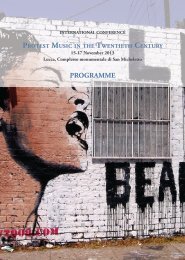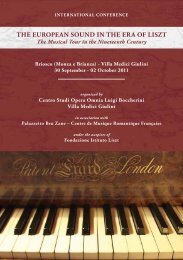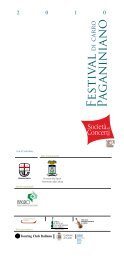emphasizing the importance on the reliance on figures. This particular stylistic tra<strong>di</strong>tion is also borneout in Boccherini’s Six Quintets for flute or oboe and strings, Op. 17. In his obituary on Boccherini,included in Volume 1 (1805) of the Berlinische musikalische Zeitung (p. 252), Johann FriedrichReichardt (1752-1814) in<strong>di</strong>cated that out composer «had already fallen into oblivion during his ownlifetime» («[…] sei von der musikalischen Welt bereits im Leben vergessen worden», as reproduced inSpeck’s article on Boccherini in MGG2, col. 133). This quest continues at present, with Boccherinirarely surfacing in modern textbooks on music history and theory. The examination of Boccherini’schamber music needs to be extended beyond the music composed for string sextet, string quintetand string quartet, with the latter genre <strong>di</strong>scussed in the secondary literature, especially in ChristianSpeck’s path breaking monograph, entitled Boccherinis Streichquartette: Stu<strong>di</strong>en zur Kompositionsweiseund zur gattungsgeschichtlichen Stellung (Munich, 1987), to include the aforementioned quintets forstrings and flute or oboe, the first quintets for a mixed chamber ensemble, and in the case of the fluteor oboe featuring repertory for either wind instrument which had received favourable recognitionin the works of the principal Viennese Classicists, among them Franz Joseph Haydn, with whomBoccherini cherished a brief correspondence in 1781.• Germán Labrador (Universidad Autónoma de Madrid):An Approach to don Luis de Borbón and Music: Re-evaluating Luigi Boccherini’s Works fromthe Arenas PeriodThe musical interests of Don Luis de Borbón influenced everyday life during his retreat at Arenasde San Pedro, whilst exiled from the Spanish Court. Luigi Boccherini accompanied Don Luisduring the last ten years of his life, but little is known about the repertoire that was played at theInfante’s Palace, near Talavera, and about musical practices in this context. Based on the evidenceof recently-<strong>di</strong>scovered documentation, which confirms that the Infante was extremely fond ofmusic and left behind an important and unknown legacy, I intend to shed light on this period ofBoccherini’s activity and practice as a composer, and also on the repertoire other than Boccherini’sthat was performed during the years at Arenas de San Pedro.• Priscille Lachat-Sarrete (Université de Paris ‘La Sorbonne’):Le soliste dans les concertos de Boccherini : le violoncelle-soliste comme dessus d’une sonateen trioL’écriture de concertos pour violoncelle suppose d’affronter deux contraintes pour permettre uncertain équilibre entre le soliste et l’orchestre : celle du timbre, car le violoncelle doit se <strong>di</strong>fférencierdes autres instruments à cordes de l’orchestre et celle de l’intensité sonore. Dans ses 12 concertos pourvioloncelle, Boccherini réussit un tour de force : permettre au soliste de s’imposer face à l’orchestresans obliger celui-ci à s’effacer pour autant. Les deux modes d’expressions favoris du violoncellistesoliste sont la virtuosité de la main droite — par la rapi<strong>di</strong>té et la variété des traits —, et de la maingauche — par le jeu dans l’aigu développant notamment la technique du pouce. Cette virtuositéne doit pas seulement éblouir, elle doit aussi produire du volume sonore et permettre au soliste dese <strong>di</strong>stinguer par le timbre tendu dans l’aigu de l’instrument. La virtuosité que Boccherini exige duvioloncelle soliste a quelque chose de spécifique : ses qualités de concertiste s’unissent à son intérêtpour la musique de chambre. Une des techniques de mise en valeur du violoncelle soliste qu’il utilisefréquemment est une transformation de l’écriture de la sonate en trio. Il adapte une écriture courantedans la musique de chambre pour lui donner un nouveau visage dans le concerto pour soliste. Entraitant le violoncelle comme un dessus, c’est-à-<strong>di</strong>re comme un violon, Boccherini crée une inégalitéqui est absente de l’écriture usuelle pour deux dessus. Il utilise aussi ce type d’écriture dans ses
quintettes à deux violoncelles. L’un des moments-clefs du concerto est l’entrée du soliste. Pour ledébut du solo, Boccherini utilise habituellement le même thème que lors du début du tutti initial,mais par plusieurs techniques d’écriture, permet au soliste de mettre en valeur son statut d’exception.Parfois le thème est orné ; le soliste joue alors le même thème mais lui appose son cachet par un jeuvirtuose. Dans plusieurs concertos, le violoncelle soliste superpose une note tenue à la répétition parl’orchestre du thème principal au ton principal. Cette écriture permet de s’immiscer dans le <strong>di</strong>scoursorchestral, puis de prendre la parole. C’est une forme de tuilage, qui semble particulièrement efficacepour le violoncelle dont le timbre n’est pas très brillant. Souvent le violoncelle est doublé par lespremiers violons à la sixte supérieure.• Ana Lombardía (Universidad de La Rioja):Boccherini’s “Six Duets for Two Violins” Op. 3 in Madrid’s Musical SceneWhen Boccherini’s Six Duets for two violins Op. 3 were reprinted in Madrid in 1772, only two sets of thisgenre had previously been published there. Nonetheless this does not in<strong>di</strong>cate that the duet for melo<strong>di</strong>cinstruments was under-cultivated in Spain, since numerous advertisements in the local press dating fromthe late 1750s onwards attest to a high demand for this music. Interestingly, not only an internationalrepertoire is advertised, but also a notable local production, which embraces both i<strong>di</strong>omatic, multimovementworks and anonymous simple dances. 40 violin duets composed in the orbit of Madridbefore 1800 have been located so far, most of them dated to the 1770s — precisely when Boccherini’sOp. 3 reached the city. This paper aims to investigate the contemporary reception of Boccherini’sduets in Madrid, focusing on patterns of consumption and inclu<strong>di</strong>ng stylistic analysis. Among otherquestions, the extent to which specific aspects of this set may have been regarded as novelties in Madridwill be considered, along with its impact on local composers such as J. Herrando, M. Plá, J. Castel, G.Brunetti, M. Canales and J. Oliver. In ad<strong>di</strong>tion, this survey will provide new insight into the genre itself,whose surge in popularity occurred in Madrid roughly at the same time as in the rest of Europe.• Alessandro Mastropietro (Università <strong>di</strong> Catania):Boccherini e la ‘forma ciclica’ come processo narrativo ‘singolativo-multiplo’Nella produzione strumentale <strong>di</strong> Boccherini, è apparsa da sempre rilevante agli stu<strong>di</strong>osi la frequente presenza<strong>di</strong> trasmigrazioni — entro <strong>di</strong>versi movimenti <strong>di</strong> un’opera — <strong>di</strong> materiale tematico o <strong>di</strong> interi blocchifraseologici o formali (riproposti più o meno testualmente), quale dato stilistico personale e <strong>di</strong>fferenzianterispetto dalla prassi compositiva or<strong>di</strong>naria dei principali compositori classico-viennesi. In questi ultimi,è assai raro — fino al primo Beethoven incluso — che nei <strong>di</strong>versi movimenti <strong>di</strong> un’opera strumentalecircolino riconoscibilmente i medesimi temi o si spostino interi episo<strong>di</strong> musicali, contrad<strong>di</strong>cendo ciò latendenza — nel secondo caso — alla trasformazione <strong>di</strong>scorsiva dei materiali, o — nel primo caso — allosviluppo concentrato e intensivo dei temi. Tale comportamento è stato generalmente definito dagli stu<strong>di</strong>osidel Lucchese ‘forma ciclica’, adattando però un concetto nato per descrivere fenomeni assai più tar<strong>di</strong>,quali quelli riscontrabili nei generi strumentali del xix secolo inoltrato, e segnati da uno sviluppo tematiconon solo assai pervasivo della forma, ma anche influenzato dalla concezione leitmotivica wagneriana.Inoltre, la definizione <strong>di</strong> ‘forma ciclica’ dovrebbe in Boccherini descrivere parimenti fenomeni collegati, masostanzialmente <strong>di</strong>fferenti, quali la circolazione tematica e la traslazione in blocco <strong>di</strong> episo<strong>di</strong>. L’assunzione <strong>di</strong>concetti prelevati dalla teoria matematica, quali ‘iterazione’ o ‘ricorsività’, pur contribuendo analiticamentea una soluzione, non sod<strong>di</strong>sferebbe del tutto. I proce<strong>di</strong>menti <strong>di</strong> Boccherini sono sì sostanzialmente iterativi,e il compositore li impiega anche nei livelli fraseologici <strong>di</strong> base; eppure, proprio nei casi <strong>di</strong> traslazionea <strong>di</strong>stanza <strong>di</strong> blocchi equivalenti a interi movimenti (processo squisitamente, apparentemente iterativo),Boccherini costruisce — nel raggio generale dell’opera — forme <strong>di</strong> secondo livello. Se non si tratta <strong>di</strong>









